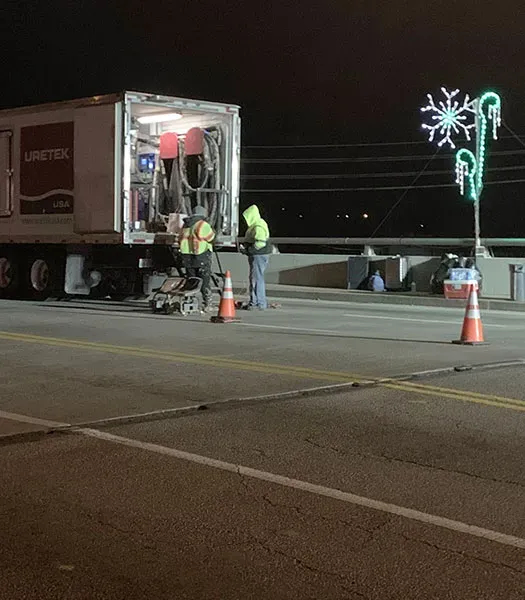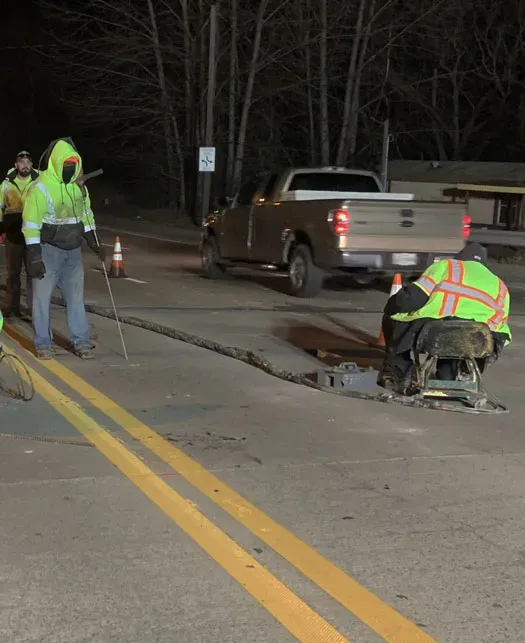Bridge Approach and Departure Ramp Repair in Pigeon Forge, Tennessee
Problem
For drivers traveling between Gatlinburg, Pigeon Forge, and Sevierville, Tennessee, there was one point in the journey down State Route 448 that was sure to be an eye-opener. Settlement of the bridge approach and departure slabs along 448 at Pigeon Forge had resulted in significant dips in the road that dramatically impacted the ride experience. As this section of road is heavily travelled by tourists, TDOT officials understood that they needed to return the bridge to a safe condition as soon as possible, and they knew they had to find a solution that would have minimal impact on traffic. TDOT officials called URETEK.
Analysis
URETEK crews arrived on the scene and inspected the bridge approach and departure slabs. The settlement issues were present across the entire north end of the five-lane bridge, and in two of the lanes on the south end of the bridge. This type of settlement is common when the bridge approach and transition are constructed over fill materials, which are often not compacted well during initial construction. URETEK Deep Injection® (UDI) was proposed for the north and south bridge approach/departure slabs and transitions, and the work was scheduled to take place on overnight shifts, to minimize the impact on traffic.
Solution
TDOT officials informed URETEK that the road was scheduled for repaving in the upcoming months. Therefore, an injection pattern intended primarily to stabilize the area was developed for the site. The UDI application was also designed to lift the bridge approaches at the transitions to minimize the amount of milling that would have to be done during the repaving process. During the first scheduled work shift, URETEK discovered that the bridge transition was not constructed as per the standard detail, which typically includes an inverted ‘T’ paving bracket (sleeper slab). Based on that discovery, the injection plan was modified and approved by TDOT before the second work shift began.
Result
This interesting project involved URETEK essentially building a “substitute” sleeper slab out of polyurethane grout. The revised injection plan was implemented, and the project was completed in a total of seven overnight work shifts. The polyurethane grouting stabilized the settled areas, and up to 1 ½ inches of lift was achieved at the transitions. The fact that the injection pattern was adjusted to compensate for the missing paving bracket greatly improved the performance of the bridge slabs and ensured that the soon-to-be repaved asphalt road would tie into a solid transition at the bridge. TDOT officials were very happy with the results, which despite the need for a completely new project plan were delivered at only a five percent increase over the originally estimated cost.
URETEK Deep Injection® (UDI)
Widely referenced throughout our industry, UDI involves the injection of structural polymer into base and subgrade soils to increase the load bearing capacity. This is achieved by injecting the polymer through small holes drilled directly through the pavement structure to depths determined by site-specific analysis. Our URETEK 486 Star® material flows easily into voids and weak zones within the soil mass below. Through a controlled chemical reaction, the expanding polymer compacts surrounding soils and applies a controlled pressure on targeted areas of the affected pavement above. If needed, a multi-injection design plan is utilized to gently return the pavement to its original grade. The composite material quickly cures into a strong, dimensionally stable, and water-resistant geo-material, providing years of reliable service.
URETEK 486 Star®
URETEK 486 Star® polymer is a two-component, high-density, expanding thermoset polyurethane system. It was developed to be the ideal solution for under-sealing, void filling, lifting of settled pavement, stabilization and stiffening of weak soils, and for encapsulating and sealing buried infrastructure. URETEK 486 Star® is environmentally inert, non-toxic, and resists underground water erosion or weakening due to its industry-leading hydrophobic properties.


